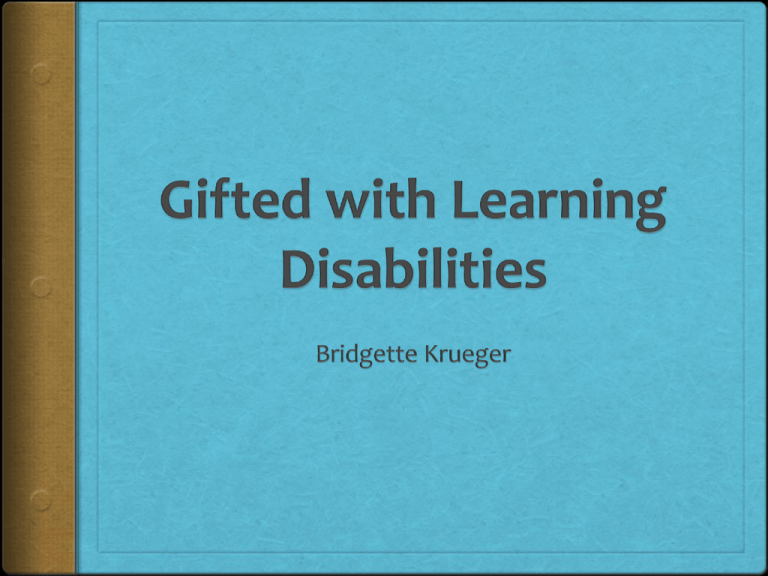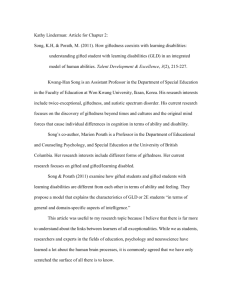Gifted with Learning Disabilities
advertisement

Outline Learning Disability Defined Types of Learning Disabilities GLD (Gifted with Learning Disabilities) Effects of GLD for girls and boys Training Areas 4 Intervention Steps Principles Activity What is a learning disability? As defined in IDEA 2004, a learning disability is a disorder in one or more of the basic psychological processes involved in understanding or in using language, spoken or written, which disorder may manifest itself in the imperfect ability to listen, think, speak, read, write, spell, or do mathematical calculations. Types of Learning Disabilities Common Types of Learning Disabilities Dyslexia: Difficulty reading Dyscalculia: Difficulty with math Dysgraphia : Difficulty with writing Dyspraxia : Difficulty with fine motor skills Dysphasia/Aphasia: Difficulty with language Auditory Processing Disorder: Difficulty hearing differences between sounds Visual Processing Disorder: Difficulty interpreting visual information ADD/ADHD: Attention deficit disorder Hyperactivity Autism Spectrum Disorder How Learning Disabilities affect Gifted Students Normally there is a disconnect between their advanced verbal ability and productive outcomes The student typically preforms in the average range with highly developed thinking skills, verbal ability, and a creative vein The misinformed see and label these children as disengaged and unmotivated Pattern of acting out withdraw into him/herself As the students begin to see the heightened gap between their strengths and weaknesses they become increasingly anxious Withdrawal from school=social dysfunction and alienation from peers GLD Frustration Formula High intelligence + Learning block = Frustration GLD Continued.. Undiagnosed GLD can cause pain to the student who works hard for mastery and is limited by a learning disability Families are also affected by the cycle of hope and despair Parents blame themselves for students unusual behaviors Siblings may feel neglected Students who come to school with a confirmed diagnosis have a head start “The challenge for the teacher is to look past the label and to seek evidence of giftedness in the students.” Dually Diagnosed Boys Common GLD behaviors: Playing classroom clown Acting aggressively Displaying poor impulsive control Constantly indulging in disruptive classroom behaviors Displaying very immature behaviors Ceaseless energy alternating with bouts of fatigue Dually Diagnosed Girls More sensitive to public perceptions Display a greater need for social acceptance Social and coping skills are well developed Perform at an average to slightly above average level due to their increased brain organization Due to the following listed above girls with GLD usually take the withdrawal route. If they do act out it is normally in the safety of their home, which causes hardships for their parents. Dually Diagnosed Girls Continued… Indulge in social behaviors such as: Bossiness Constant talking Interfering in everybody’s business Teacher pleasing Taking leadership of the girl talk/drama Being catty Using their leadership skills to influence other girls to victimize other students Dual Exceptionality Training GLD students require training in these areas: Social Emotional Behavioral Communicative Competence Misdiagnosis and Missed Diagnosis Errors arise when professionals misinterpret behaviors “Both misdiagnosis and missed diagnosis occur when giftedness and its characteristics are confused with a pathological condition such as ADHD, OCD, ODD, or Asperger’s Disorders.” Gifted individuals may purposefully camouflage behaviors Missed diagnosis or misdiagnosis decreases the chance that proper interventions will be implemented. Gifted with Learning Disability Intervention Program Step 1- Identifying GLD students GLD Preschool Profile Parent Information Checklist Standardized-Test Results Teacher Observation Step 2- Analysis of Specific Needs Learning-Styles Analysis Multiple- Intelligence Checklist Specific Learning Difficulty Report Wechsler Test of Intelligence Agency Reports Gifted with Learning Disability Intervention Program Continued… Step 3- Eradicating Learned Helplessness Training in Metacognition Regular Conferencing Sessions Mapping Change Emotional and Social Skills Training Counseling Step 4- Designing and Individual Program Slaying the Dragon Direct Daily Intervention Curriculum Compacting Celebrating the Gift The Mentor Program Effective Principles Choices Teaches responsibility for decisions/ choices Encourages children to think for themselves Reason effectively=make good choices Expressing confidence=increase in child’s self esteem Token Economy List out directions for student to see and to look back at during the activity Schedule for students to see the daily activities Effective Principles Continued… Maintain a structured classroom Routine Clearly defined rules and expectations Praise for following rules Train organizational skills and goal setting Use teacher attention to motivate Lessons should be motivating Centers include ideas to stimulate creative minds Teach self monitoring Identify students’ strengths Activity Look at the materials on the table. In a minute you will be creating a structure that is meaningful to you. Take a few minutes to to manipulate the materials. You may taste, smell, and touch the materials to begin jogging your memory/imagination. After manipulating the materials, plan out what you want to build. (It can be written or drawn out) After planning your structure, use the materials to build the structure. Next, explain your structure/object to the group. What it is Why it’s meaningful to you Where you saw it Etc. References Daniels, S., & Piechowski, M. M. (2009). Debrowski's Theory: Possibilities and Implications of Misdiagnosis, Missed Diagnosis, and Dual Diagnosis in Gifted Individuals. Living with intensity: understanding the sensitivity, excitability, and emotional development of gifted children, adolescents, and adults (pp. 83-103). Scottsdale, AZ: Great Potential Press. Hill, F. (2007). Teaching gifted learners: Book B: The hidden gifted: Meeting the needs of gifted students with learning disabilities. Hawthorne, NJ: Educational Impressions, Inc. National Association of Special Education Teachers: Introduction to Learning Disabilities. (n.d.). National Association of Special Education Teachers: Teachers Teaching Exceptional Children. Retrieved July 7, 2012, from http://www.naset.org/2522.0.html Parker, H. C. (1994). The ADD hyperactivity workbook for parents, teachers, and kids (2nd ed.). Plantation, Fla.: Specialty Press.




